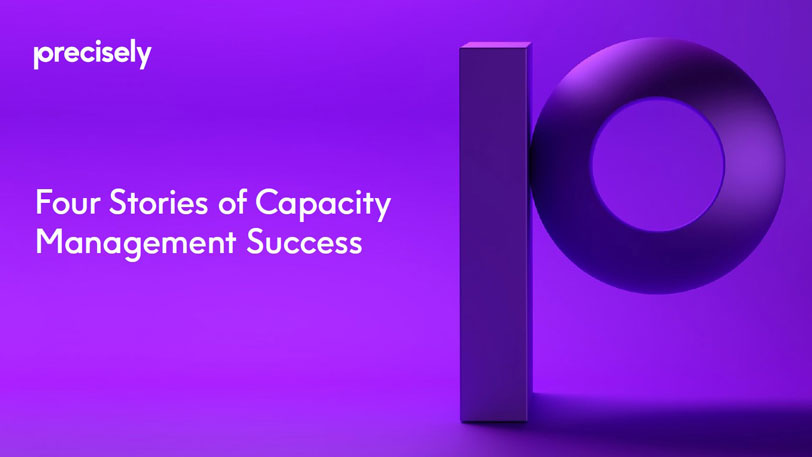eBook
Four Stories of Capacity Management Success
IT Executives Don’t Run The Business… They Just Keep It Running.
Regardless of size or market, online or brick and mortar, your business is essentially 100 percent dependent upon ever-increasing streams and stores of data, and therefore, upon the systems and applications that handle them. Ultimately, this means it is dependent upon you to ensure that your infrastructure is right sized, reliable and performing perfectly at all times.
The challenge is that the definitions of “right-sized” and “performing perfectly” keep changing, seemingly on a daily basis, making it so easy to get it wrong. Having underutilized or idle resources can be just as harmful to your business as not having enough processing capacity or network bandwidth. And as for reliability, any instances of failure to perform will inevitably be costly. They will also be clearly visible to your customers, especially your internal customers.
In short, how well you manage your IT infrastructure will either contribute to enabling or disabling the business. To succeed, you need full visibility into every aspect of your current operations as well as accurate and timely assessments of your infrastructure’s ability to handle near-term and long-term changes to business requirements.


Proactive, Automated and Integrated
It is no longer efficient, or even possible, to properly manage your infrastructure with manual processes performed in an ad hoc, incident
based manner. You have to be able to continuously monitor, assess, adjust and restructure every part of your multi-platform, distributed, interconnected and internet-dependent cyber-multiverse to respond to constantly changing business requirements.
The only way you can hope to achieve this is to implement proper capacity management and capacity planning processes supported by integrated, automated tools. Essentially, you need to be able to:
- Identify and resolve emergent systems capacity and performance issues in real-time
- Accurately assess and quantify the impacts on your systems of both expected and potential changes to business requirements
Inevitably, this requires resources. You have to achieve these goals while under very real resource constraints, namely time and money. To get what you need will require justifying the cost and even proving a net positive ROI for your investments.
The good news is that the value of implementing capacity management and capacity planning is most definitely positive and provable, both in terms of tangible monetary value and in less tangible but no-less-valuable benefits that accrue to the business. When both direct budgetary savings and cost savings from avoiding incidents and unnecessary IT expenditures can be identified and quantified, the case for capacity management becomes compelling.
The Value of Capacity Management and Capacity Planning
The first step toward realizing real value is to take the right approach. Build capacity management and capacity planning best practices right into your operations and enable them with the right tools. Start with a clear view of what you need to achieve and the most pressing problems you want to resolve.
But as you build your plan, keep alert to the full value of each process. Look not only at the direct benefits and improvements to systems performance and reliability you can achieve, but also look for the next-level benefits that your customers, internal and external, will gain from your solution. In other words, think like your customers.
To illustrate, consider the following examples of companies who have succeeded with this approach. Each had specific capacity management and capacity planning problems and needs that needed to be addressed. And each found further, unexpected benefits and value in their results.

Business Focus: Group and Individual Insurance
Employees: 3,500
Market Reach: Multiple States in the USA
Customer Base: 50+ Million Covered Individuals
A national insurance firm challenged itself to achieving comprehensive capacity management and capacity planning across their extensive, multiplatform infrastructure and to improving control of their extensive cloud-based development operations. Their existing collection of tools and processes were not able to handle the complexities of their mix of over 1,700 on-premise and AWS cloud-based HP-UX, Windows, Solaris and Red Hat servers.
So with strong support and guidance from their CIO, who understood the real potential value of capacity management done well, the capacity management team engaged outside experts to help asses their current and future capacity requirements. They also sought out advice on industry best practices and on building the business case and cost justification for scaling up their capabilities.
Consumer Financial Services
- Comprehensive capacity management and capacity planning capabilities, spanning not only the current mix of systems but also other major platforms they might add in the future
- The ability to scale and to quickly and fully integrate additional systems during potential mergers and acquisitions
- Full commitment to more stringent SLAs for availability, reliability and stability
- Best-in-class modeling and visualization capabilities to support infrastructure planning and overall IT budgeting
- Customizable analytics and reporting/charting to enable more productive internal customer engagement regarding systems utilization and planning
- Clearly demonstratable ROI
Key Results
- Fully automated analysis and reporting against consolidated system performance data from all platforms
- More proactive avoidance of potential outages, with as many as 15,000 potential incidents avoided per month
- Greater control over “zombie servers” in the AWS Cloud, resulting in better cost containment and cleaner DevOps environments
- CIO and five IT VPs more fully supported through extensive, individually focused reporting
- Improved ability to prove “Value Delivered” through detailed, quantifiable reporting of outages and incidents avoided, staff utilization efficiencies, OpEx cost control
- Better management of resource contention and processing volume peaks during annual open enrollment periods
Business Focus: Infrastructure Management, Hosting Services
Employees: 44,000+
Market Reach: 25 Countries
Customer Base: Cross Industry, Private and Governmental Organizations
To remain competitive and profitable, the company needed to deliver more extensive, timely and understandable reports and guidance to their customers regarding the infrastructure and systems entrusted to them. Their top objective was to provide superior value-add services and be able to document and demonstrate the cost efficiency and business value of their services.
The company manages over 4,000 servers and upwards of a petabyte of data, across both on-premise and Cloud systems, including extensive presence on AWS, Azure and UK Cloud, running Unix/AIX, VMWare, Linux, Windows and Solaris.
With their multi-national footprints, both their private and government customers demand complete control, security and regulatory compliance with regards to data and systems management. The company must deliver absolutely accurate and transparent reporting regarding both service costs and systems configuration and utilization.
Capacity Management Core Requirements
- High volume capture/ingest of system management data streams from multiple sources, including standard platform-specific capacity management data as well as relevant data from multiple business applications and databases.
- Customizable analysis and reporting, with intelligent, prioritized visualization of key trends and anomalies.
- Flexible and robust modeling tools and charting capabilities, useable by mid-and upper-level managers without resorting to hand coding.
Key Results
- Able to bring together system data from zOS, zLinux, SMF, SAS MXG and multiple other sources for integrated and correlated analysis and reporting.
- Powerful visualization engine and mature charting tools combine to enable exceptionally flexible and robust analytics.
- Reports and charts created for analysis that are easily automated for ongoing production use.
- Simplified and accelerated modeling of physical and virtual infrastructure changes, such as reconfiguration and application of LPAR’s for efficiency and minimization of utilization charges.
Business Focus: Multi-Line Insurance, Investment Planning and Management
Employees: 50,000+
Market Reach: 80+ Countries
Customer Base: Consumers and Investment Management Professionals
Serving millions of customers and managing billions of dollars of investments and insurance obviously requires extensive and complex IT systems, which in turn require huge investments in time, money and people to manage. While multiple interdependent mainframe systems serve as the core of its infrastructure, the company also relies upon many other platforms running the full range operating systems in both on-premise and cloud environments.
To keep such a large and complex infrastructure running, and to keep both their OpEx and CapEx budgets under control, the company needs to have complete, 24/7 visibility into capacity utilization across all its platforms, at scale. The central focus of their capacity management team is system operations data analysis and reporting, with incident avoidance as the ultimate goal.
Capacity Management Core Requirements
- Comprehensive capacity utilization, trend analytics and reporting. Is the client “right-sized” and getting the best value from their investments with us? What is changing? What will they need tomorrow?
- Continuous, detailed visibility into threats and issues – Identifying operational anomalies and resolving them preemptively.
- Ability to leverage extensive system reporting data for what-if modeling of opportunities for additional cost savings.
Key Results
- Serving a wider range of customers by integrating/correlating analysis and reporting across multiple platforms, enabling a more comprehensive and unified view of client infrastructure than clients could achieve on their own.
- Proving the value of their current services by tracking and reporting the number and nature of capacity incidents avoided through their capacity management efforts.
- Stronger engagement with clients and development of “Trusted Partner” relationships through collaborative modeling of future requirements, which in turn supports the clients’ complex budget planning efforts.
Business Focus: Consumer Savings and Mortgage Lending
Employees: 2,500+
Market Reach: Over 200 Branch Locations in the United Kingdom
Customer Base: 2 Million+
The capacity management team at a major consumer banking firm needed to aggressively manage the costs of the systems underpinning their various lines of business. They also needed to be able to document and communicate IT issues and results to the heads of the business. Increasingly stringent banking regulations, including expanded rules under the UK Financial Conduct Authority regarding potential personal liability for senior banking managers, further added to the urgent need for data-driven reporting to prove compliance.
Although the firm is organized and managed as a group of semiautonomous Lines of Business (LOBs), IT operations, including capacity management and planning, are centralized and serve as a shared resource. This organizational structure naturally drives heightened visibility and accountability for business results from LOB level management, but can also result in more assertive competition between them for critical IT resources.
Strong growth across all LOBs drove constantly increasing demand for many additional customer-facing and back-office applications, and the ability to capture and report on increasingly voluminous and detailed business information. The result was that the Capacity Management team was struggling to manage the rapidly growing and diverse collection of LOB-specific applications and databases.
Capacity Management Core Requirements
- Capacity management and planning tools capable of covering all the operating systems, applications and databases currently in use. Ability to add others in the future.
- Comprehensive yet easily customizable analytics, to enable companywide and LOB-focused reporting.
- Highly automated, to enable future growth without having to add multiple head counts.
Key Results
- Successfully capturing and processing not only standard system management data for analysis, but also important business statistics and data in network-, application- and database-specific formats from over 25 sources, including SQL queries, Python scripts.
- Proactive and rapid response to potential outages and incidents.
- Reduction in overall hardware footprint by identifying and preventing over-subscription of resources.
- More complete and effective network utilization analysis and control.
- Able to correlate E-Commerce transaction loads with CPU utilization for proper charge-back accounting to each LOB.
- Advanced capacity management trend analysis and modeling capabilities resulting in more accurate planning and budgeting, especially regarding DevOps.
- Charts and reports that are easily understood by LOB Leadership teams, leading to far more informed, cooperative and supportive IT resource sharing and planning.
- Web portal-based report delivery, directly accessible by LOB leadership, eliminating costly and cumbersome paper-based processes.
What Do You Need To Achieve?
The reality is that you are already spending time and money to handle the unavoidable need to manage systems capacity, performance and planning. But, are you spending wisely? Are you getting the level of results from your investment that you really need?
Can you prove it?
The preceding examples should provide some food for thought on those questions. You can bring your capacity management and capacity planning practices up to the level that your business needs and deserves. The key to getting it done is to understand and communicate to all your stakeholders the true, full value of the endeavor, in terms they can appreciate:
- Avoiding unnecessary costs from incidents that stem from incomplete planning or visibility.
- IT OpEx control resulting from putting your team’s higher-level skills and talents to better use than bogging them down with manual processes, spreadsheet-based analysis and reporting, and costly fire-fighting.
- Automated analysis and reporting that delivers both the detailed, comprehensive, cross-platform information you need as well as highly accessible, stakeholder-friendly visibility into the issues important to key decision makers.
- Facilitating and improving information sharing with and between your key stakeholders. In other words, enabling more effective and cooperative discussions based upon facts and information focused on their needs.
- Better control and reduction of infrastructure CapEx and OpEx through deeper and more comprehensive trend analysis and advanced, powerful and flexible What-If modeling of future needs.
- Revenue enhancement resulting from business leaders making better decisions based upon more timely and complete understanding of the IT systems they rely upon.


The Most Important Capacity Management Questions
With so many benefits and such demonstratable financial value on offer, the first question should not be if, but rather how you scale up your capacity management efforts. And the answer to that question, like just about everything you are responsible for, lies in leveraging your available systems and data fully and intelligently.
Automated, interoperable and deeply integrated capacity management tools, combined with a programmatic commitment to the goal, will enable you to more effectively mine your system operations data for the answers to all those questions your business leaders are asking – even the ones they haven’t yet thought to ask but, will (inevitably) ask you tomorrow.
Precisely can help you scale up your capacity management efforts.